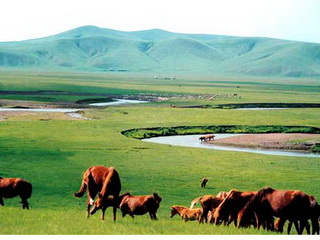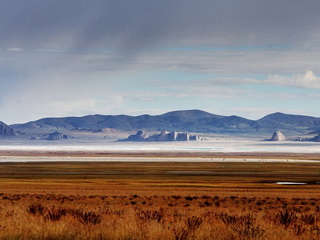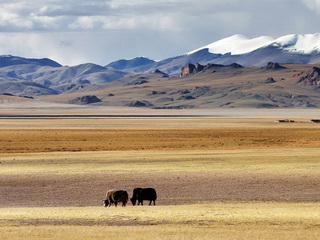search for a Trip
The Qiangtang National Nature Reserve focused on steppe ecoregion and alpine rare animal species. Tibetan antelope is one of the most distinct species in the region. The allure of Shahtooshi and its economic value have attracted armed poachers, the most fierce threat to Qiangtang, to the area. Before 1996, poachers hunted over 4000 Tibetan antelopes every year.
 After 1997, the Tibet Forestry Department, in cooperation with conservation organizations such as WWF Nagchu, began promoting and organizing anti-poaching patrols in seven counties in Nagchu and Ngari prefectures. In addition, international organizations have taken action to stop trade of animal products and markets, which has also contributed to help control the illegal poaching in Qiangtang.
After 1997, the Tibet Forestry Department, in cooperation with conservation organizations such as WWF Nagchu, began promoting and organizing anti-poaching patrols in seven counties in Nagchu and Ngari prefectures. In addition, international organizations have taken action to stop trade of animal products and markets, which has also contributed to help control the illegal poaching in Qiangtang.
As a result of such efforts, illegal poaching has been greatly reduced. Based on actual cases and reported figures, illegal poaching of antelope has been reduced to under 400 per year and armed large scale hunting has been controlled.
Hundreds of Tibetan gazelles and Tibetan wild asses, kiangs in Tibetan, roamed in the broad rangelands as we were driving through the Nyima County section of the Qiangtang National Nature Reserve. Seemingly getting used to jeeps and even trucks, the wild animals showed no signs of fear when people were approaching. "Obviously the wildlife are well-protected here," said Dawa Tsering, the Tibet Program co-ordinator of the World Wild Fund for Nature (WWF) China Program Office.
Located in Ngaqu Prefecture in the northern Tibet Autonomous Region, Nyima is one of five counties - Nyima, Gegyai, Gerze, Rutog, and Amdo - and a special administrative district, Shuanghu, within the limits of jurisdiction of the Changtang National Nature Reserve, the country's largest nature reserve with an area of about 298,000 square kilometers in north and northwestern Tibet.


In Nyima County, the local Tibetans have become more aware of the importance of protecting wildlife. Most people have been on guard. But the public's awareness of the conservation of the wildlife in Nyima does not mean there are no conflicts between humans and nature.
Every year the county government would organize four large-scale patrols in the 100,000-square-kilometre protected area of the county, which has a total area of about 150,000 square kilometers. Most rangers intensified their patrols "especially in the winter season when chirus gather to mate and in early summer when they gather to calve." The local forestry police and rangers of townships also organize patrols regularly.
The local reserve rangers' efforts and even their lives have not gone unnoticed. In the reserve under Nyima County's jurisdiction, we saw hundreds of chirus gathering to prepare to mate in the morning. They were very close to local human settlement. Male adults with their male offspring, female adults with their female offspring - they were scattered on the broad rangeland into several big groups. The female groups leisurely grazed on the slope.
After realizing of people's approach, a group of male chirus galloped towards another group of females in a tidy line, seemingly to their rescue. Their black knotty horns are conspicuous under the scorching sunshine.
Related Tours:
China Attractions Guide
- Anhui Attractions
- Beijing Attractions
- Chongqing Attractions
- Fujian Attractions
- Gansu Attractions
- Guangdong Attractions
- Guangxi Attractions
- Guizhou Attractions
- Hainan Attractions
- Henan Attractions
- Hongkong Attractions
- Hubei Attractions
- Hunan Attractions
- Inner Mongolia Attractions
- Jiangsu Attractions
- Jiangxi Attractions
- Manchuria Attractions
- Ningxia Attractions
- Qinghai Attractions
- Shaanxi Attractions


